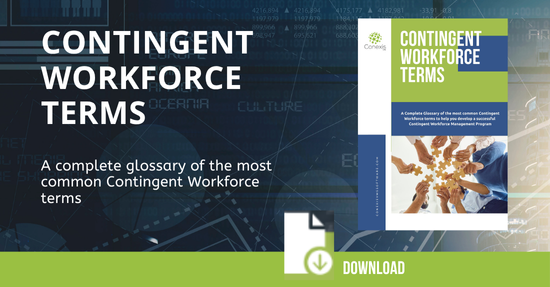Everything You Need to Know About Contingent Workforce Management 2026 | Conexis VMS
What is Contingent Workforce Management?
Contingent workforce management is the strategic process of sourcing, organizing, and optimizing external workers - such as independent contractors, freelancers, temporary staff, and consultants - who are not part of your company’s full-time workforce.
This guide breaks down the different components of a contingent workforce program, its benefits and risks, and why a modern Vendor Management System (VMS) like Conexis is the most effective tool for managing your contingent workforce.

What are the Components of a Contingent Workforce Program?
Your Contingent Workforce Program should include these key components:
1 - Centralized Visibility: Costs, KPIs: Gain a clear view of all external workers, costs, and performance metrics.
2 - Defined Processes: Standardize onboarding, offboarding, compliance, and engagement.
3 - Compliance Controls: Establish protocols to ensure legal and tax compliance.
4 - Partnerships: Work with reliable vendors to fill roles quickly and compliantly.
5 - Technology Integration: Use a Vendor Management System (VMS) to automate workflows, track spend, and ensure compliance.
What are the Benefits of an Effective Contingent Workforce Program?
Managing your contingent workforce strategically provides numerous benefits, including:
Cost Savings:
Reduce overhead and avoid long-term employment costs. To attract full-time employees companies must spend money on benefits and other incentives that help them to attract and retain the top talent. By using contingent workers, however, companies only need to pay non-employee workers for the work they actually do.
Flexibility:
Scale labor up or down quickly to match business needs. The use of contingent workers gives companies the ability to assess company needs on an ongoing basis. Whether an organization needs expertise on a short-term basis or seasonal workers during a peak season, the contingent workforce gives companies the capability to immediately meet their workforce targets.
Access To Talent:
Engage specialized skills not available .internally. Acquiring top talent is more competitive than it has ever been before. Organizations are now contending with their competition to access in-demand talent from a small pool of workers. Using contingent workers is a great way for organizations to navigate the skills gap and hire hot skills for immediate positions.
Faster Hiring:
Fill skill gaps and roles more quickly
Reduced Risk:
With the right tools and processes, mitigate risks related to misclassification and non-compliance.
About Contingent Workers
What are the Differences Between Contingent Workers and Employees?
When building an internal contingent workforce, compliance is crucial. Companies must comply with local regulations and laws, making sure not to misclassify their contingent workers as contingent when lawmakers would see them as employees.
This can be difficult, because the difference between a contingent worker and a traditional employee isn't always clear and classification laws vary in each country, state and even city.
There are three important factors that distinguish the difference between contingent workers and employees:
- Contingent Workers are not on the company payroll. Contingent Workers are hired for a defined period of time.
- Unlike employees, contingent workers are only hired either for a defined period of time or for a specific project.
- Contingent Workers are typically not eligible for benefits. Some contingent workers are not eligible for the same benefits that employees are entitled to, such as vacation time, sick pay, bonuses or retirement plans. However, this can become confusing as it differs depending on the category or worker and the location they are beings sourced. T4 or W2 contingent workers are sourced via a staffing agency, for example are entitled to classic employee benefits although it's typically the staffing agency who provides these benefits and not the hiring organization.
Types of Contingent Workers
The contingent workforce is a pool of non-employee workers who are hired by an organization on an on-demand or project-by-project basis. These workers are not considered employees of a company. Instead, they work under a contract or a temporary basis.
- Unlike permanent employees, contingent workers are only with an organization for the continued existence of the job at hand - whether that be completing a specific project or working for a pre-determined period of time.
- Once this short term engagement is completed, a contingent then moves on to a new job with a different organization.
- Contingent workers come in many forms, each offering different levels of flexibility and risk.
- The term independent contractor is an umbrella term for different types of workers, such as freelancers, consultants and gig workers.
- Understanding the type of contingent worker you're engaging helps determine the appropriate onboarding, compliance, and management processes.
The most common types of Contingent Workers include:
Temporary workers
Temp workers are hired through staffing agencies Temporary workers are typically employed through a staffing agency, placed within your organization to fill specific staffing requirements you have. They generally work for a business for a predetermined period of time to meet seasonal demands, fill temporary positions or help companies scale up rapidly.
Freelancers
Freelancers are hired directly for short-term tasks, Freelancers are self-employed professionals who offer services on a proejct-by-project basis usually without long term commitments. They are independent contractors who set their own rates, choose their clients, and determine their own work schedule
Independent Contractors
Independent Contractors provide specialized services, Independent contractors, who are classified as self employed and not placed within a business by a staffing vendor, are usually hired to work on projects or to perform a defined set oof deliverables and deadlines. They are able to work from where and when they want, and are generally experts in the specific field they are working in.
Consultants
Consultants engaged for strategic expertise. A consultant is a professional who provides advice or services in an area of specialization.
Gig Workers
Gig workers do quick, task-based jobs using digital platforms for on-demand work.
Measuring Your Contingent Workforce Program
The Key Performance Metrics (KPIs) to Measure Your Contingent Workforce Program
Here are the key metrics that gauge the success of a contingent workforce management program:

Time-to-Fill
A key metric for assessing staffing vendors and internal processes is time-to-fill. This metric scrutinizes the calendar days (or hours for high volume) it takes to fill a position, from the initiation of a temporary position posting to its successful fulfillment or resource assignment commencement.
Evaluating vendors on this metric is not only instrumental in their improvement but also crucial in assessing the end-to-end process efficiency, ensuring timely placement of skilled workers.
Turnover
While turnover is anticipated in a temporary workforce, excessively high turnover signifies potential issues. It could indicate subpar worker experiences, misalignment in staffing agency placements, non-competitive rates, or delayed assignment renewals. Reducing turnover in a contingent workforce program is vital for optimizing time, effort, and the cost associated with attracting and onboarding new talent. Being able to pinpoint specific job categories, business units or geographies, to name a few, with high turnover, helps organization address root causes and improve this metric.
Time to Submit
Distinguishing itself from time-to-fill, time-to-submit measures the duration it takes a staffing agency to submit candidates. This metric unveils insights into the efficiency of the contingent workforce management program, highlighting bottlenecks between submission and the fill/start date. Identifying factors such as resume screening timeframes, managerial delays, interview processes, and backcheck inefficiencies is crucial for streamlining the overall process.
Fill Rate
The fill rate, comparing received temporary position orders to the number of job orders filled monthly by staffing agencies, serves as a pivotal metric.
Low fill rates may signal inadequate processes, underperforming agencies, or rate card issues. Gaining clear visibility into fill rates empowers organizations to rectify these issues promptly.
The Role of a VMS in Contingent Workforce Management
What is a VMS and why it's essential in managing your Contingent Workforce Program
Many organizations are still using manual spreadsheets, in-house databases or Sharepoint-like websites to manage their contingent workforce.
This is simply ineffective - and where a vendor management system will help.
A VMS is a cloud or web-based platform that acts as a mechanism for an organization to procure and manage its non-employee workforce. It’s a software platform that supports a company in structuring and optimizing every process related to contingent workforce management.
By automating every process in contingent workforce management and consolidating all vendors and information into one centralized location, a vendor management system significantly improves how you manage each step in the contingent workforce management process from sourcing, hiring, tracking and invoicing non-employee workers.
This leads to better visibility into your program, significant cost savings, improved process efficiencies, and contingent workforce compliance.
What are the Benefits of a Vendor Management System?
A VMS will bring a huge ROI to your company’s contingent workforce management program, and that’s because it’s capabilities will significantly improve your processes, reduce costs and lead to far greater visibility into your program.
Improved efficiencies:
The automation of processes such as onboarding, time entry and approval will save your organization countless hours and lead to better internal efficiencies across your company.
Complete visibility into your program:
Since your entire contingent workforce management program is now stored in one location, instead of being fragmented across different departments and hiring managers, you’ll have complete visibility into where you may be overpaying vendors or mismanaging contingent workers.
Vendor consolidation:
With your vendors consolidated into one location, your VMS will act as a central hub that gives you all the information you need to evaluate whether each staffing agency you use is helping you to meet your company’s unique workforce targets. This leads to more insightful and strategic vendor choices.
Reduce costs:
By helping you to get the lowest prices from vendors, cut down on rogue spend in your contingent workforce management program and save money on process efficiencies, a VMS can help your business improve its contingent workforce management expense - to improve your bottom line and become more profitable.
Business impacts of implementing a Vendor Management System
Here are some of the cost and efficiency benefits that a VMS can bring to your contingent workforce program:
98% - The compliance rate achieved on average
55% - The average reduction in temp turnover
51% - The average that time-to-fill metrics are improved by
12.6% - The average hard cost reduction from improved visibility and control
13.9% - The average soft cost savings from efficiency gains

How Do I Know I need a VMS?
How do I know I need a VMS to Manage my Contingent Workforce Program?
Here are several questions you can ask yourself to identify whether you will benefit from implementing a Vendor Management System.
Take this quick survey to find out if you need a Vendor Management System.
.png)
Choosing a Vendor Management System
Choosing the Right VMS for Your Contingent Workforce Program
Here are some considerations when choosing the right VMS for your organization:
The ability to consolidate vendors:
For clear visibility into your staffing agencies and vendor performance, a VMS should be able to consolidate all of your vendor information into one centralized location. This will improve how you manage, and analyze the performance, of those vendors.
Automation of processes:
A VMS solution is a significant improvement from managing your contingent workforce using spreadsheets because the software should be able to automate your processes. Look for a vendor management system that can automate all of the time-consuming processes associated with managing your vendors, from sourcing, onboarding, analyzing performance, payment processing and much more.
Vendor standardization:
Want to prevent rogue spend from occurring across your contingent workforce program? A VMS solution will improve vendor standardization across your business. This will act as a framework for how hiring managers across your entire company use and pay vendors.
Centralization of your program:
Contingent workforce programs require a large amount of data, including both vendor information and worker information. The ability to centralize this in one centralized location will ensure your company has complete visibility into its program and that company policies around this workforce are being followed by all departments. This increased visibility ensures you are also able to view program performance and make better vendor/hiring decisions moving forward.
Additional VMS Features:
Other top features that you should look out for in a VMS solution should include: Simplicity of use, Invoicing, Process requisitions, Process approvals, Onboarding tools, Scalability for company growth and Visibility into vendor performance.
Choosing a VMS for a Mid-Market Contingent Workforce Program
For organizations managing a contingent workforce program with an annual spend under $70 million – selecting the right Vendor Management System (VMS) is critical.
- Your VMS should provide a scalable, efficient, and comprehensive solution without requiring multiple systems or extensive customization.
- Yet when it comes to companies transforming how they manage their contingent workforce program, many of the traditional legacy VMS providers have designed their software for large organizations with enterprise-level contingent workforce volumes.
When choosing the best VMS for your mid-market program, ensure that it has been specifically designed and built to meet your needs, and provides you with the flexibility, affordability and customer care you need.
For additional information, check out our Mid-Market Contingent Workforce Guide.
Why Choose Conexis VMS
Why Choose Conexis as your VMS Partner
Our software has been developed by contingent workforce experts and was built from the ground up using the latest tech stack. This means we can do more for you at a lower cost, with more flexibility, provide better customer care, and deliver a better user experience.
Conexis is an award-winning VMS tailored specifically for mid-market contingent workforce programs. Built on the latest tech stack, we are THE most modern, advanced and innovative VMS on the market today. We deliver the expertise, reliability, and security of an enterprise system, while offering the flexibility, user friendliness and tailored service you require. Essentially, Conexis delivers enterprise level software - without the enterprise level complexity and cost.
Here's why you should choose Conexis as your VMS Partner.
 Our Expertise
Our Expertise
At Conexis, our Leadership Team brings extensive 'hands-on' experience in the Contingent Workforce Industry, particularly in Workforce Management, Consulting, Procurement and Talent Acquisition roles.
Industries:
This expertise spans across various industries including Consulting, IT, Manufacturing & Light Industrial, Consulting, Government, Pharma, Warehouse & Logistics and Healthcare.
Our Tailored Solutions:
We also bring a tailored solution for MSPs, Staffing Agencies, HR and Talent Acquisition, Procurement, and Contingent Workforce Management Professionals.
With Conexis, you get dedicated senior leadership to help you succeed.
 Our Advanced Technology
Our Advanced Technology
We have the most modern and advanced VMS tech stack available today. It starts with the latest codebase and extends to our lightning-fast AWS microservice infrastructure. Add to that our Open API and Software Development Kit (SDK), making Conexis the lights-out leader in VMS technology. Our open APIs and flexible data solutions also allow our customers to create fast, easy, and cost-effective integrations, that can be done in under a week, compared to the legacy systems, which have to custom code each one.
 Our Flexible Pricing
Our Flexible Pricing
We offer flexible pricing with no set up costs. We offer a range of pay-as-you-go pricing models. In addition, some highlights of our pricing include: Flexible Percentage of Spend or Licence Fee Pricing, free setup and implementation, no cost standard customization and configuration included, no Cost API, and no cost for a dedicated account team. You can save money, not only at set up, but on an ongoing basis with our affordable monthly pricing.
 Our Work-Shifts, Worker Scheduling & Credentialling
Our Work-Shifts, Worker Scheduling & Credentialling
We are one of the only VMS' in the market with functionality designed specifically to support high-volume fluid workforce environments. With our market-leading work shift scheduling, advanced timekeeping, and worker credentialing capabilities, Conexis is the only VMS that can handle all skill categories without clunky third-party add-ons.
 We're Easy to Use
We're Easy to Use
The Conexis user interface was created using system design science. Our goal was to create an intuitive, easy-to-use, and easy-to-navigate interface. And we have succeeded. Our system is easy-to-use and easy-to-navigate. Our customers also report much higher levels of adoption due to our user interface and easy-to-use flows.
 Our Clients Highly Recommend Us
Our Clients Highly Recommend Us
According to SIA's 2025 Workforce Solution Buyers Survey, the Net Promoter Score (NPS) for the VMS Industry in 2025 is -28. Yes. That's negative 28, not positive 28. Comparatively, among current users, we report a higher-than-industry NPS score of +71. This means that our clients would highly recommend our system to others.
 Our Unbeatable Customer Care
Our Unbeatable Customer Care
"91.7% of all user inquiries are resolved within three hours". We are so proud of this statistic. Conexis puts a premium on Customer Care. We are on a mission is to make every customer feel like our number one customer because they are! Our Customer reviews are authentic and market leading. Each customer is supported by a dedicated and highly experienced "We Care" team that meets rigorous SLA levels to ensure the client's questions are addressed immediately.
 Our Advanced Analytics and AI
Our Advanced Analytics and AI
Our advanced reporting and analytics module gives customers valuable insights into their program’s performance and contingent workforce population. This critical information enables improved decision-making to improve quality, speed, compliance and cost. Combine this data with our impressive set of AI-driven tools, like candidate matching, to put your program into high gear.
 Our Fast Implementation
Our Fast Implementation
No longer does it take 4-6 months to implement a VMS. Conexis is built on the latest tech stack and we can have you up and running within a few weeks. With turnkey solutions, modular design, and streamlined integration capabilities, VMS implementation can now be completed in weeks instead of months.
 Our “Easy Switch” Program
Our “Easy Switch” Program
It’s easy to switch your VMS to Conexis with the Conexis “Easy Switch” program. Conexis makes switching your VMS easy. Our dedicated "Easy Switch" Team will take care of every detail for you, ensuring a seamless transition with minimal disruption. We handle all the complexities, so you can focus on your core business activities without any interruptions and be fully operational in just a few weeks.
 Our White Label Partner Program
Our White Label Partner Program
Because we are built on the very latest tech stack, we can provide you with a fully White Labeled VMS your own unique URL, for a very affordable rate. The benefit of a white label VMS is that it enhances your product offering and provides a seamless experience for your clients.
Grow Your Business with a Master Vendor Program
If you are looking to increase revenue and grow your business through a Master Vendor Program, we can help. Our White-Label VMS is exactly what you need and can be customized with your brand for a seamless client experience.
 Our Mid-Market Focus
Our Mid-Market Focus
Leveraging the latest technology, Conexis delivers the expertise, reliability and security of enterprise systems, while offering the flexibility, user friendliness and tailored service you require. Conexis delivers enterprise level software - without the enterprise level complexity and cost for Mid-Market Contingent Workforce Programs.
 Our Client Testimonials
Our Client Testimonials
At Conexis, we believe that the true measure of our success lies in the voices of those we serve. Our clients' feedback is invaluable, offering genuine insights into the transformative impact our solutions have on their businesses. By reading our Conexis Client testimonials, you will discover firsthand accounts of how Conexis has revolutionized their operations, enhanced efficiency, and delivered exceptional value. These stories are a testament to our commitment to excellence and our dedication to helping our clients achieve their goals. Dive into their experiences and see why Conexis is the trusted partner for so many.
 Our Native Shift Based Worker Functionality
Our Native Shift Based Worker Functionality
Unlike other VMS platforms that offer shift scheduling as an afterthought, Conexis was designed with native shift-based workforce management at its core. This means you can manage all scheduling, pay rates, and compliance in one system, reduce payroll and invoicing errors, have real-time workforce visibility with instant access to who is working, who is available, and where gaps exist; and scalability - so you can easily manage shift-based workforces across multiple locations and job types.
 Our Open API
Our Open API
Our VMS has Open APIs which gives you the ability to access raw data and create custom reporting suites tailored to your needs, which enhances the quality of service and drives operational efficiencies and scalability.
By harnessing the power of Open APIs, you can transform your reporting capabilities, providing users and clients with the insights they need to manage their contingent workforce effectively.
 Our Nexi AI Support Agent
Our Nexi AI Support Agent
Artificial Intelligence (AI) is reshaping the future of Vendor Management Systems (VMS) - and Conexis is leading the charge. We've launched Nexi AI, our AI Support Agent built to transform the way users interact with the platform, access support, and manage their contingent workforce programs.
 Our Partnership
Our Partnership
At Conexis, our priority is on building partnerships and helping you succeed and grow. We offer many Conexis partner programs, so if you are a Staffing Agency, MSP, Contingent Workforce Consultant or HR Technology Provider looking for a VMS Partner who wants to help you grow your business, contact us!
Contingent Workforce Terms
Key Contingent Workforce Management Terms
This glossary is designed to provide simple, straightforward definitions of the most common terms and acronyms in the contingent labor space - so you can communicate with confidence and clarity.
Download a free copy of our Contingent Workforce Terms Guide
1099 Employee
A worker classified as an independent contractor for tax purposes; they receive a 1099 form to report income on their tax return.
AI (Artificial Intelligence)
Artificial intelligence (AI) refers to the ability of computers or machines to perform tasks that typically require human intelligence, such as learning, problem-solving, and decision-making. It involves creating systems that can reason, learn, and act to solve complex problems.
Alternative Staffing
Alternative staffing is a generic term that refers to the hiring of individuals on a part-time or as-needed basis. The term refers to any worker that doesn’t fall under the regular, direct, and full-time employment. Alternative staffing arrangements typically refers to those working under short-term contracts.
Applicant Tracking System (ATS)
A software application that enables the electronic handling of recruitment needs.
Background Checks
The process of verifying that an individual is who they claim to be, which may include checking criminal records, education, employment history, and other activities from the past.
Assignment
Assignment refers to either the period of time a contingent worker is working with a business, or the task or duty that is being performed. Once the assignment is finished, their contract with an organization is up.
Bench
The group of contingent workers who are currently not on an assignment but are available for work.
Bill Rate
The rate a staffing agency charges to a client for the services of each temporary worker.
Co-Employment Risk
The risk that a client company and staffing agency become viewed as joint employers of a contingent worker, thereby sharing legal responsibilities and liabilities.
Co-Sourcing
A staffing model where a portion of the service is outsourced to an external service provider, while some strategic control remains with the internal team.
Compliance
Adherence to laws and regulations governing contingent workforce engagements, including classification of workers, tax implications, and labor laws.
Compliance Tracking
Monitoring and recording compliance with industry regulations and labor laws.
Contingent RPO (Recruitment Process Outsourcing)
A form of business process outsourcing where an employer transfers all or part of its recruitment processes to an external service provider, but only for contingent labor.
Contingent Workforce
A labor pool consisting of individuals hired by an organization on a non-permanent basis, such as freelancers, independent contractors, consultants, and temporary contract workers.
Contingent Workforce Consulting
Professional services provided by experts to help organizations develop strategies and practices for effectively managing their contingent workforce.
Contingent Workforce Outsourcing (CWO)
The practice of using an external organization to manage all or part of the processes and activities associated with the contingent workforce.
Contingent Workforce Program (CWP)
An organizational program that manages all aspects of a company's contingent labor, including staffing, procurement, and compliance.
Contingent Workforce Strategy
A business's approach to managing and optimizing the use of contingent labor.
Contract-to-Hire
A type of employment arrangement where a worker is initially hired on a temporary contract with the potential to become a permanent employee.
Cost Per Hire
The total cost associated with the recruitment of new employees, including advertising expenses, recruiter fees, and staff time.
DEI
DEI stands for Diversity, Equity, and Inclusion. It's a framework used by organizations to promote a workplace where all individuals feel valued, respected, and have equal opportunities, regardless of their background or identity. This includes fostering a culture where differences are acknowledged, embraced, and supported.
Direct Sourcing
The strategy of sourcing candidates directly rather than through third-party staffing agencies or search firms.
Employer of Record (EOR)
A service that acts as the official employer for tax purposes while the employee performs work at a different company.
Engagement Manager
A role that involves the day-to-day management of contingent workers, ensuring that they are effectively integrated into the team and productive.
Flex-Staffing
An employment arrangement that allows workers to have variable schedules and workloads based on employer needs.
Freelancer
An individual who works as a self-employed person, offering services to multiple clients at a time.
Full-Time Equivalent (FTE)
A unit that indicates the workload of an employed person in a way that makes workloads comparable across various contexts.
Gig Economy
The segment of the economy that operates on short-term contracts or freelance work as opposed to permanent jobs.
Human Capital Management (HCM)
The set of practices related to people resource management, specifically in the categories of workforce acquisition, management, and optimization.
Human Resource Outsourcing (HRO)
Contracting out various HR tasks, such as payroll and benefits administration, to a third-party provider.
Independent Consultant
A professional who provides expert advice in a particular area and operates independently, not as an employee of a company.
Independent Contractor
An individual in business for themselves who provides services to another entity as a non-employee. Deemed a 1099 in the United States
Job Bidding
The process in which potential employees, including contingent workers, bid on tasks or projects by proposing their qualifications and rate for the job.
Labor Categories
Classifications of jobs that have similar knowledge, skills, and abilities that are used to standardize contract labor qualifications.
Managed Service Provider (MSP)
A third-party company that manages a client's contingent workforce program. MSPs are responsible for the end-to-end management of the contingent workforce, including selection, engagement, management, and analysis of workforce spending.
Margin
The difference between the bill rate and the pay rate measured as a percentage of the Bill Rate. Example: John gets paid $100 perm hour and the staffing agency adds $50 to the rate making the bill rate $150. The margin is calculated as (150-100)/150 = 33% Margin. This is often confused with the term markup which is calculated off the pay rate.
Market Rate
The average price and range of pricing in the staffing industry for contingent worker services.
Markup
The difference between the bill rate and the pay rate measured as a percentage of the pay rate. Example: John gets paid $100 per hour and the staffing agency adds $50 to the rate making the bill rate $150. The markup is calculated as (150-100)/100 = 50% Markup. This is often confused with the term margin which is calculated off the bill rate.
Master Service Agreement (MSA)
A contract reached between parties, in which the parties agree to most of the terms that will govern future transactions or future agreements.
Master Vendor
A master vendor is where a single staffing agency assumes full responsibility for all of a company’s staffing needs. They will fill the roles themselves, or if they cannot fulfill the roles, they will outsource them to other staffing agencies.
Merger & Acquisition (M&A) Talent
The practice of hiring or utilizing existing contingent workers to support the transition and integration processes during a merger or acquisition.
MSP Fee
The fee that the MSP charges for the services it provides. Often based on a percentage of the supplier invoices.
Non-Employee
A non-employee is any worker who is not an employee of any organization. This could be anyone in the contingent workforce, such as a freelancer, consultant, independent contractor, or temporary worker.
Non-Compete Agreement (NCA)
A contract between a worker and an employer that restricts the worker from entering into competition with the employer after the employment period is over.
Non-Disclosure Agreement (NDA)
A legally binding contract that establishes a confidential relationship between the employer and the worker.
Offboarding
The procedure for transitioning a contingent worker out of the company at the end of their contract.
On-Demand Talent
Highly skilled professionals who are available to work on a flexible basis, often remotely, and can be engaged quickly to meet business requirements.
Onboarding
The process of integrating a new worker into an organization, including training and orientation.
Performance Management
The assessment and improvement of work performance and the provision of feedback to contingent workers.
Professional Employer Organization (PEO)
An outsourcing firm that provides services such as employee benefits, payroll, and workers' compensation, often for small businesses.
Project-Based Hiring
A recruitment approach that focuses on acquiring talent for a specific project rather than for an ongoing role.
Quality of Hire
A metric used to evaluate the value a new hire adds to a company, in terms of performance and tenure.
Ramp Up Time
The time it takes for a contingent worker to become fully productive in their new role.
Rate Card
A document containing the prices and descriptions for the various services a company provides, which can be used as a negotiating tool between the company and its clients.
Resource Allocation
The process of assigning and managing assets in a manner that supports an organization's strategic goals.
Pay Rate
The amount of money a contingent worker receives which is often different from the bill rate due to markups by staffing agencies.
Rogue Spend
Rogue spend is spending that occurs on sourcing, engaging, and hiring contingent workers in scenarios that are not accounted for, not approved, and have not followed a strategic approach. This typically occurs when spreadsheets are used over vendor management software.
Service Delivery Manager
A professional who oversees the delivery of services or service technology to a company's clients or customers.
Skill Gap
The difference between the skills required for a job and the actual skills possessed by the employees.
Skills Inventory
A database or list that an organization maintains of the skills, qualifications, and interests of its current and potential employees, including contingent workers.
Service level agreement (SLA)
An SLA is a document that describes the minimum levels of service quality a supplier should comply with. This typically involves key performance indicators such as time-to-submit and time-to-fill.
Staffing Agency
An organization that recruits employees for businesses that need to fill positions on a temporary, seasonal, or permanent basis.
Statement of Work (SOW)
A formal document that captures and defines the work activities, deliverables, and timeline a vendor must execute in performance of specified work for a client.
Statutory Deductions
Statutory deductions, also known as payroll deductions, are mandatory amounts withheld from an employee's gross pay by their employer, as required by law. These deductions are typically used to fund government programs and services, such as income tax, social security, unemployment insurance, and Medicare.
Supplier Diversity
Supplier diversity is a business strategy that actively incorporates diverse-owned businesses, suppliers, and vendors into a company's supply chain and business practices. This includes sourcing goods and services from companies that are at least 51% owned and operated by underrepresented groups, such as women, ethnic minorities, veterans, LGBTQ+ individuals, and people with disabilities.
Supplier Scorecard
A series of metrics that are tracked and then reported on to show how a supplier is performing against specific key performance indicators, targets, and peer suppliers.
T4 Employee
An employee in Canada who has a direct relationship with his or her employer not supplied via a third-party vendor or an independent contractor.
Talent Acquisition
The process of finding and acquiring skilled human labor for organizational needs and to meet any labor requirement.
W2 Employee
A W-2 employee is a worker whose employer deducts taxes from their wages and reports their annual earnings to the IRS using a W-2 form.
Worker Classification
The process of determining whether a worker is an independent contractor or an employee for purposes of taxation and compliance.
Workforce Analytics
The use of data analysis techniques to understand, improve, and optimize the management of the workforce.
Worker Credentials
The specific credentials that are required by the employer of the worker and must be maintained current. Fir example a fork lift license or nursing license.
Workforce Diversity
The inclusion of a wide variety of people of different races, genders, ages, religions, disabilities, ethnicities, sexual orientations, and education levels within a workforce.
Workforce Mobilization
The ability of an organization to rapidly move workers from one assignment to another to meet changing market demands and project needs.
Workforce Planning
The analytical process for anticipating and managing the needs of the business regarding the talent acquisition.
Vendor
A vendor is a person or company offering a service or product for sale. In the contingent workforce, a vendor refers to a staffing agency who fills job requests.
Conexis Contingent Workforce Management Resource Hub
How to Manage Contingent Workforce Risk
Read how to manage contingent workforce compliance risk
How to Increase Contingent Workforce Visibility
Read how you can gain more visibility into your contingent workforce
How to Manage Contingent Workforce Rogue Spend
Read how you can better manage rogue spend your contingent workforce program
How to Track Contingent Workforce Compliance
Read how you can track contingent workforce compliance
How to Measure Contingent Workforce Programs
Read how you can measure your contingent workforce program

Are you looking for an easier way to manage your contingent workforce?
Let's Talk!
Our powerful, yet easy to use vendor management system has been built on the latest technology and designed with the user in mind. Making it the perfect solution for any sized business looking to get control of their entire contingent workforce and the suppliers that provide them.






